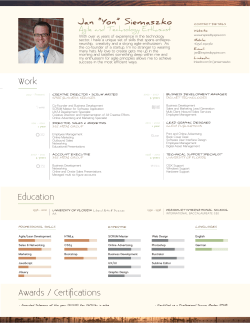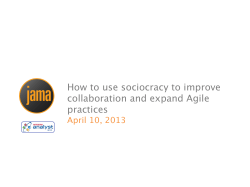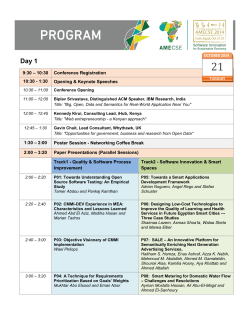
Agile Processes: eXtreme Programming Data taken from SDLC 3.0 book; Google;
Agile Processes: eXtreme Programming Data taken from Ganesh.Sambasivam@isoftplc.comak SDLC 3.0 book; Google; Scattered Notes Thumbnail Sketch • XP is the most widely recognized agile method. • Developed by Kent Beck, Ward Cunningham, and Ron Jeffries and is based on the method and their experiences at Daimler Chrysler. • Captured attention with its very name! XP Values • XP is based on – four values and – twelve practices • that have been extended various ways since XP’s introduction XP Values • Communication. Most projects fail because of poor communication. So implement practices that force communication in a positive fashion. – This is one of the four Agile values – a bit reworded but really the same value. • Simlicity. Develop the simplest product that meets the customer’s needs • Feedback. Developers must obtain and value feedback from the customer, from the system, and from each other. – The same as standard Agile values: value customer collaboration over contract negotiation. • Courage. Be prepared to make hard decisions that support the other principles and practices. Thoughts (1 of 2) You can readily see that XP is Agile: • Work is performed by small teams that include a customer continuously present on site. • XP begins with the planning game, where customers and developers negotiate requirements in the form of stories captured on index cards. • The system concept is captured in terms of a metaphor (ahead) to support a single vision of success. • The fundamental short cycle time (iteration) is no more than three weeks. Thoughts (2 of 2) Continuing: you can readily see that XP is Agile: • The technical process assumes collective ownership of the product so that anyone can work on anything. – This fits with simple design, pair programming, and emergent design through refactoring to work. • Coding standards are established by the team, and quality is assured through a test-first approach and continuous integration. • A sustainable pace is achieved through emphasis on a 40-hour work week. Comments on XP • XP: a strong track record for achieving success in small applications. • Scaling is an issue w20-person team often stated as absolute upper limit. • XP: been tried w/multiple teams, but there’s little experience with this. • Simple design and YAGNI (see next slide) are often inappropriate for stable systems with predictable evolutions. • Beck identified several other barriers to using XP – teams not collocated, – long feedback cycles, and – long integration processes. • See Beck, 1999, Extreme Programming Explained: Embracing Change, Reading, MA. Addison-Wesley. YAGNI – Essential to XP • According to those who advocate the YAGNI approach, the temptation to write code that is not necessary at the moment, but might be in the future, has the following disadvantages: – The time spent is taken from adding, testing or improving necessary functionality. – New features must be debugged, documented, and supported. – Any new feature imposes constraints on what can be done in the future: an unnecessary feature now opens possibility of conflict with necessary feature later. • Until feature is actually needed, Difficult to fully define what it should do and to test it. • If the new feature is not properly defined and tested, it may not work correctly, even if it eventually is needed. • This leads to code bloat; software becomes larger and more complicated. • Adding the new feature may suggest other new features. – If these new features are implemented as well, this may result in • snowball effect towards feature creep. XP by Kent Beck • XP conceived and developed to address the specific needs of software development conducted by – small teams – in the face of vague and changing requirements. • XP is a lightweight methodology • Challenges many conventional tenets, – including long held assumption: cost of changing a piece of software necessarily rises dramatically over the course of time. XP Fundamentals by Kent Beck • Write unit tests before programming; keeping all tests running all times. • Integrating and testing the whole system--several times a day. • Producing all software in pairs, two programmers at one screen. • Starting projects with simple design. Simple design can evolve. • Putting a minimal system into production quickly and growing it in whatever directions prove most valuable. XP Controversies • Why? Some sacred cows don’t make the cut in XP: • Don’t force team members to specialize: analysts, architects, programmers, testers, and integrators— • every XP programmer participates in all of these critical activities every day. • Don’t conduct complete up-front analysis and design— – XP project starts with a quick analysis of the entire system, and – XP programmers continue to make analysis and design decisions throughout development. • Develop infrastructure and frameworks as you develop your application, not up-front--delivering business value is heartbeat driving XP projects. • Don’t write and maintain implementation documentationcommunication in XP projects occurs face-to-face, – or through efficient tests and carefully written code XP by Kent Beck • Kent says: – You may love XP or you may hate it, but Extreme Programming Explained will force you to take a fresh look at how you develop software. XP Core Practice #1- The Planning Game • Business and development cooperate to produce max business value as quickly as possible. • The planning game: – Business comes up with a list of desired features. – Each feature is written out as a User Story, • feature has a name, and is described in broad strokes what is required. – User stories are typically written on 4x6 cards. – Development estimates how much effort each story will take, and how much effort the team can produce in a given time interval. – Business then decides • order of stories to implement, • And when and how often to produce a production release of the system. XP – Core Practice #3: Simple Design • Simplest possible design to get job done. • Requirements will change tomorrow, do what's needed to meet today's requirements • Design in XP is not a one-time; an all-thetime thing. Have design steps in – release planning – iteration planning, – teams engage in quick design sessions and design revisions through refactoring, • through the course of the entire project. XP – Core Practice #4: Metaphor • Extreme Programming teams develop a common vision of how the program works, which we call the "metaphor". • At its best, the metaphor is a simple evocative description of how the program works. • XP teams use • common system of names to be sure that everyone understands how the system works • and where to look to find the functionality you're looking for, • or to find the right place to put the functionality you're about to add. XP – Core Practice #5: Continuous Testing • XP teams focus on validation of the software at all times • Programmers develop software by writing tests first, and then code that fulfills the requirements reflected in the tests. • Customers provide acceptance tests that enable them to be certain that the features they need are provided. XP – Core Practice #6: Refactoring • XP Team Refactor out any duplicate code generated in a coding session. • Refactoring is simplified due to extensive use of automated test cases. XP – Core Practice #7: Pair Programming • All production code is written by two programmers sitting at one machine. – This practice ensures that all code is reviewed as it is written and results in better Design, testing and better code. • Some programmers object to pair programming without ever trying it. – It does take some practice to do well, and you need to do it well for a few weeks to see the results. – Ninety percent of programmers who learn pair programming prefer it, so it is recommended to all teams. • Pairing, in addition to providing better code and tests, also serves to communicate knowledge throughout the team. XP – Core Practice #8: Collective Code Ownership • No single person "owns" a module. • Any developer is expected to be able to work on any part of the codebase at any time. XP – Core Practice #9: Continuous Integration • All changes are integrated into the codebase at least daily. • Unit tests have to run 100% both before and after integration. – Infrequent integration leads to serious problems on a project. • Athough integration is critical to shipping good working code, the team is not practiced at it, and often it is delegated to people not familiar with the whole system. • Problems creep in at integration time that are not detected by any of the testing that takes place on an un-integrated system. • Code freezes mean that you have long time periods when the programmers could be working on important shippable features, but that those features must be held back. XP – Core Practice #10: 40-hour Week • Programmers go home on time. – In crunch mode, up to one week of overtime is allowed. • Multiple consecutive weeks of overtime are treated as a sign that something is very wrong with the process and/or schedule. XP – Core Practice #11: On-Site Customer • Development team has continuous access to the customer who will actually be using the system. • For initiatives with lots of customers, a customer representative (i.e. Product Manager) will be designated for Development team access. XP – Core Practice #12: Coding Standards • Everyone codes to the same standards. • The specifics of the standard are not important: what is important is that all of the code looks familiar, in support of collective ownership. XP Values – Summarized. • XP is a values-based methodology. The values are Simplicity, Communication, Feedback and Courage. • XP’s core values:best summarized in the following statement by Kent Beck: Do more of what works and do less of what doesn’t. Highlights of the four values itemized: • Simplicity encourages: – Delivering the simplest functionality that meets business needs – Designing the simplest software that supports the needed functionality – Building for today and not for tomorrow – Writing code that is easy to read, understand, maintain and modify Highlights of the four values itemized: • Communication is accomplished by: – – – – – – – – Collaborative workspaces Co-location of development and business space Paired development Frequently changing pair partners Frequently changing assignments Public status displays Short standup meetings Unit tests, demos and oral communication, not documentation Highlights of the four values itemized: • Feedback is provided by: – – – – – – Aggressive iterative and incremental releases Frequent releases to end users Co-location with end users Automated unit tests Automated functional tests Courage is required to: • Do the right thing in the face of opposition • Do the practices required to succeed Conclusion • Extreme Programming is not a complete template for the entire delivery organization. • Rather, XP is a set of best practices for managing the development team and its interface to the customer. • As a process it gives the team the ability to grow, change and adapt as they encounter different applications and business needs. • And more than any other process we have encountered Extreme Programming has the power to transform the entire delivery organization, not just the development team.
© Copyright 2025














